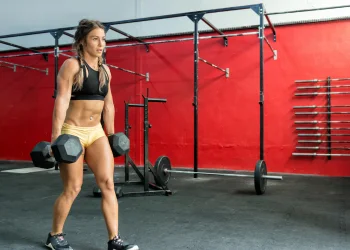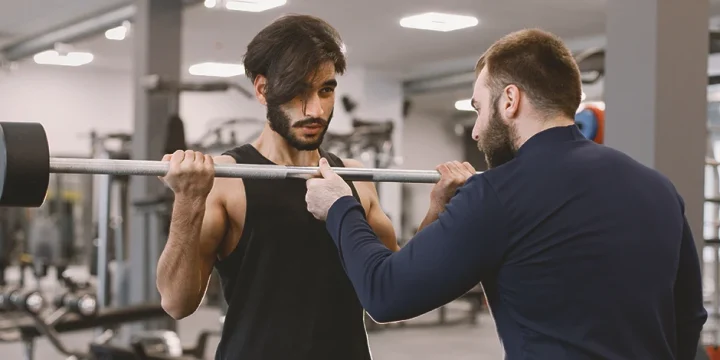The farmer's carry is a highly effective and functional exercise that has been utilized in one form or another essentially for centuries to develop total body strength, stability, and muscle endurance.
This exercise can be performed with various equipment, but for optimal results, I recommend using the following: a trap bar, dumbbells, and high-quality adjustable kettlebells.
From my extensive experience as a certified fitness trainer, as well as the three months I dedicated to examining the benefits my clients have derived from the farmer's carry workout, I have compiled a thorough evaluation.
It will guide you on the proper execution of this exercise to maximize its advantages and seamlessly integrate it into your fitness routine.
Quick Summary
- The farmer's carry workout is a functional exercise that enhances total body strength, stability, and muscle endurance by walking with weights in each hand.
- It targets multiple muscle groups, including grip, core, upper back, and lower body, leading to improved strength and muscle development.
- According to the National Institute of Health, the farmer's carry significantly improves grip strength and wrist stability.
- As a fitness enthusiast, I believe the farmer's carry is an essential exercise for functional fitness, offering benefits like improved posture and cardiovascular conditioning.
How to Do Farmer’s Carry

To perform the farmer's carry exercise, enhance your grip core strength, and maintain a straight line throughout the movement.
Follow these steps:
1. Select the Weight
I advise selecting weights that not only challenge your handgrip strength but also allow you to maintain proper form.
I recommend starting with lighter dumbbells, kettlebells, or farmer's carry handles that offer a solid grip, especially for beginners.
Gradually increase the weight as your strength and confidence grow.
2. Pick Up the Weights
Maintain an upright posture, with your feet shoulder-width apart and your core tight for stability, as you bend your knees slightly and hinge at your hips to lower yourself down and securely grip the weights from the floor using either an overhand grip or a suitcase carry grip.
Also Read: Can You Lift Weights Every Day
3. Walk with Control

With the weights in hand, initiate the movement by walking forward.
Maintain an upright posture, keeping your shoulders back and down, your chest lifted, and your gaze fixed straight ahead.
Focus on taking small, deliberate steps, emphasizing control and stability throughout the exercise.
Avoid excessive bouncing, swaying, or twisting of the body to maintain a straight line from head to toe.
4. Lower the Weights
After completing the desired distance or time, come to a controlled stop and carefully lower the weights back to the floor while maintaining proper form and control.
Bend your knees and hinge at your hips, ensuring a safe descent as you gently place the weights down without any sudden movements.
What is the Farmer's Carry?

The farmer's carry, also called the farmer's walk, is a functional strength exercise that involves walking while carrying weights in each hand.
It is inspired by the traditional task of farmers carrying heavy objects, such as buckets of water or feed, over long distances.
In this exercise, you hold weights, typically dumbbells or kettlebells, in each hand and walk for a specific distance or time.
A farmer’s walk can also be performed using a trap bar.
By performing this exercise, a trap bar farmer's carry gives you a more comfortable grip and a more even load distribution.
“The farmer's carry is a fundamental movement pattern that mimics real-life tasks, such as carrying grocery bags or moving furniture. It builds not only strength but also endurance and resilience, making it a valuable exercise for both strength training and everyday functionality."
- Tony Gentilcore, Strength Coach & Co-Founder of Cressey Sports Performance
The Muscles Trained

Farmer’s walk is a full-body exercise; practicing this exercise involves the work of major muscle groups.
Muscles you can train with a farmer's walk are:
Grip Strength
The exercise heavily engages the muscles of the forearms, including the flexor muscles, which, according to the National Institute of Health (NIH), are responsible for improving grip strength and wrist stability [1].
Core Muscles
The farmer's walk requires strong core activation to maintain stability and an upright posture while carrying the weights.
The deep abdominal muscles, obliques, and lower back muscles all contribute to core strength and stability during this exercise.
Related: Top Core Exercises
Upper Body Muscles
The muscles of the upper body are actively involved in the farmer's carry.
This includes the deltoids (shoulder muscles), trapezius (upper back muscles), rhomboids (muscles between the shoulder blades), and the muscles of the chest and arms.
According to NIH, these muscles work synergistically to stabilize and support the weights during the walk [2].
Lower Body Muscles

The farmer's walk targets lower body muscles like the quads, hamstrings, glutes, and calves.
These muscles stabilize, power, and control leg movements while walking [3].
Hamstrings are key in hip and knee movements with each step, strengthening the hip joint during the exercise.
Plus, the farmer's carry boosts whole-body coordination and posture control.
"The farmer's carry is a highly versatile exercise that can be modified to suit various fitness levels and goals. Whether you're a beginner looking to build strength or an advanced lifter aiming to improve grip strength and conditioning, the farmer's carry has got you covered."
- Dan John, Strength Coach
Farmer’s Walk Benefits

I find that the farmer's walk provides numerous benefits, enhancing overall strength, stability, and functional fitness for my clients.
Here are some of the key benefits of incorporating farmer's walks into your training routine:
Enhanced Posture
Consider all variations of carries as dynamic standing planks.
Maintaining proper posture while carrying weights is essential to prevent discomfort, look graceful, and reduce the risk of injury.
Improved Breathing
Breathing into your chest while hauling heavy weights is more challenging than you might think.
Adopting a deep belly breathing pattern, which is reinforced during carries, promotes more efficient and effective breathing.
Enhanced Shoulder Stability
The rotator cuffs and deltoids work diligently to keep your shoulder socket in place, even when faced with the resistance of heavy dumbbells attempting to pull them out.
Both muscles engage isometrically during carries, and the prolonged time under tension contributes significantly to shoulder stability.
Boosted Grip Strength

As a trainer, I emphasize that grip strength is crucial both in and out of the gym.
It's essential for pulling exercises, as your ability to grip affects how well you can perform movements like the farmer's walk.
Plus, a strong grip is linked to increased longevity.
Enhanced Mental Toughness
As your grip weakens, your muscles start to burn, and your lungs beg for air during carries, there's a little voice in your head urging you to quit.
Each time you silence that voice and persist, you cultivate greater mental strength and resilience.
Enduring the discomfort and refusing to quit carries over into all aspects of life, fortifying your mental toughness.
Incorporating a farmer’s walk into your fitness routine offers a multitude of benefits, including improved posture, enhanced breathing, shoulder stability, grip strength, and mental toughness.
By embracing these advantages, you can experience significant improvements in both your physical and mental well-being.
Common Mistakes

I always remind my clients to be aware of common mistakes while performing the farmer's walk to ensure proper form and maximize benefits.
Using the Wrong Weight
While you shouldn’t be afraid to use a heavier weight, if your form is compromised, that weight is too much.
Keep the weight heavier when going shorter distances and lighter if you’re carrying for a longer distance, such as 40 to 60 meters.
Not Keeping the Core Engaged
Any time you are upright and moving, you’re engaging the muscles in your core.
The power, stability, and support generated from these muscles will help you move quicker and protect your lower back from injury.
Leaning Forward at the Waist
Performing the farmer’s walk bent over at the waist causes pain and discomfort in the lower back.
This can happen when you get fatigued, and your technique begins to suffer. To properly perform this move, brace your core, stand tall, and look straight ahead for the duration of the exercise.
Poor Upper Back Positioning

During farmer's carries, it's common for lifters to compensate for fatigue by raising their shoulders high, which is beneficial during shrugs.
However, to optimize upper back activation and maintain proper form, it's important to keep the shoulders back and down throughout the exercise.
By doing so, you effectively engage and strengthen your lat muscles throughout the entire movement while also preventing the weights from resting on your sides.
Excessive Swinging or Bouncing
Allowing the weights to swing excessively or bounce up and down can strain the muscles and increase the risk of injury.
Maintain control over the weights and focus on smooth, controlled movements without unnecessary swinging or bouncing.
Integration with Other Training Regimens
The farmer's carry is a versatile exercise that can be seamlessly integrated into various training regimens, enhancing its effectiveness.
- In circuit training, it serves as an excellent transitional exercise, building endurance and grip strength between high-intensity stations.
- Its inclusion in CrossFit workouts complements explosive movements, improving overall functional fitness and core stability.
- In strength training, the farmer's carry acts synergistically with compound lifts, reinforcing posture and shoulder stability, crucial for exercises like deadlifts and squats.
By incorporating it, athletes can expect improved muscular coordination and balance, essential for a well-rounded fitness routine, making it a valuable addition across diverse training methodologies.
FAQs
How Effective Are Farmer Carries?
Farmer's carries are highly effective exercises; aside from developing core stability, farmer walk improves overall strength, functional fitness, and cardiovascular conditioning exercise.
Incorporating farmer's carries into your routine has functional fitness benefits, as it mimics real-life activities involving carrying heavy objects, thereby improving your ability to perform daily tasks with ease.
How Long Should I Do Farmer Carries?
For optimal results, perform farmer carries for 30-60 seconds per set. This duration balances endurance and strength training, suitable for most fitness levels. Adjust based on personal capability and goals.
Does a Farmer Carries Build Muscle?
Yes, the farmer's carry is a highly effective exercise for building muscle in multiple muscle groups, such as the grip, forearms, shoulders, upper back, core, and lower body, as it engages these muscles while providing a beneficial cardiovascular stimulus.
What Happens if I Do Farmers Walk Everyday?
Doing the farmer's walk daily can significantly enhance grip strength, overall endurance, and core stability. However, it's crucial to balance rest and recovery to prevent overtraining and ensure muscle growth and optimal fitness gains.
References:
- https://www.ncbi.nlm.nih.gov/books/NBK526046/
- https://www.ncbi.nlm.nih.gov/books/NBK537056/
- https://www.physio-pedia.com/Hamstrings
About The Author
You May Also Like






